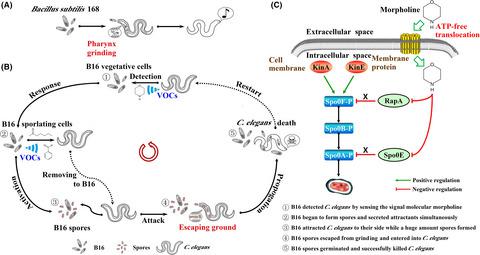当前位置:
X-MOL 学术
›
Microb. Biotechnol.
›
论文详情
Our official English website, www.x-mol.net, welcomes your
feedback! (Note: you will need to create a separate account there.)
Molecular mechanism of the smart attack of pathogenic bacteria on nematodes.
Microbial Biotechnology ( IF 4.8 ) Pub Date : 2019-11-15 , DOI: 10.1111/1751-7915.13508 Lin Zhang 1, 2 , Yuping Wei 1 , Ye Tao 1 , Suya Zhao 1 , Xuyang Wei 1 , Xiaoyan Yin 1 , Suyao Liu 1 , Qiuhong Niu 1
Microbial Biotechnology ( IF 4.8 ) Pub Date : 2019-11-15 , DOI: 10.1111/1751-7915.13508 Lin Zhang 1, 2 , Yuping Wei 1 , Ye Tao 1 , Suya Zhao 1 , Xuyang Wei 1 , Xiaoyan Yin 1 , Suyao Liu 1 , Qiuhong Niu 1
Affiliation

|
Nematode–bacterial associations are far‐reaching subjects in view of their impact on ecosystems, economies, agriculture and human health. There is still no conclusion regarding which pathogenic bacteria sense nematodes. Here, we found that the pathogenic bacterium Bacillus nematocida B16 was sensitive to C. elegans and could launch smart attacks to kill the nematodes. Further analysis revealed that the spores of B. nematocida B16 are essential virulence factors. Once gaseous molecules (morpholine) produced from C. elegans were sensed, the sporulation of B16 was greatly accelerated. Then, B16 showed maximum attraction to C. elegans during the spore‐forming process but had no attraction until all the spores were formed. The disruption of either the spore formation gene spo0A or the germination gene gerD impaired colonization and attenuated infection in B16. In contrast, complementation with the intact genes restored most of the above‐mentioned deficient phenotypes, which indicated that the spo0A gene was a key factor in the smart attack of B16 on C. elegans. Further, transcriptome, molecular simulations and quantitative PCR analysis showed that morpholine from C. elegans could promote sporulation and initiate infection by increasing the transcription of the spo0A gene by decreasing the transcription of the rapA and spo0E genes. The overexpression of rapA or spo0E decreased the induced sporulation effect, and morpholine directly reduced the level of phosphorylation of purified recombinant RapA and Spo0E compared to that of Spo0A. Collectively, these findings further support a ‘Trojan horse‐like’ infection model. The significance of our paper is that we showed that the soil‐dwelling bacterium B. nematocida B16 has the ability to actively detect, attract and attack their host C. elegans. These studies are the first report on the behaviours, signalling molecules and mechanism of the smart attack of B16 on nematodes and also reveal new insights into microbe–host interactions.
中文翻译:

病原菌智能攻击线虫的分子机制。
鉴于线虫-细菌对生态系统、经济、农业和人类健康的影响,线虫-细菌关联是影响深远的课题。关于哪些病原菌能感知线虫,目前还没有定论。在这里,我们发现病原菌杀线虫芽孢杆菌B16对秀丽隐杆线虫敏感,可以发起智能攻击杀死线虫。进一步分析表明,杀线虫B. nematocida B16的孢子是重要的毒力因子。一旦检测到秀丽隐杆线虫产生的气态分子(吗啉),B16 的孢子形成就会大大加速。然后,B16 在孢子形成过程中对秀丽隐杆线虫表现出最大的吸引力,但直到所有孢子形成才具有吸引力。孢子形成基因spo0A或萌发基因gerD的破坏都会损害 B16 中的定植并减弱感染。相反,与完整基因的互补恢复了大多数上述缺陷表型,这表明spo0A基因是 B16 对线虫进行智能攻击的关键因素。此外,转录组、分子模拟和定量 PCR 分析表明,来自线虫的吗啉可以通过减少rapA和spo0E基因的转录来增加spo0A基因的转录,从而促进孢子形成并启动感染。 rapA或spo0E的过表达降低了诱导孢子形成的效果,并且与Spo0A相比,吗啉直接降低了纯化的重组RapA和Spo0E的磷酸化水平。 总的来说,这些发现进一步支持了“特洛伊木马”感染模型。我们论文的意义在于,我们证明了土壤细菌B. nematocida B16 具有主动检测、吸引和攻击其宿主线虫的能力。这些研究首次报道了 B16 对线虫的智能攻击的行为、信号分子和机制,也揭示了微生物与宿主相互作用的新见解。
更新日期:2019-11-15
中文翻译:

病原菌智能攻击线虫的分子机制。
鉴于线虫-细菌对生态系统、经济、农业和人类健康的影响,线虫-细菌关联是影响深远的课题。关于哪些病原菌能感知线虫,目前还没有定论。在这里,我们发现病原菌杀线虫芽孢杆菌B16对秀丽隐杆线虫敏感,可以发起智能攻击杀死线虫。进一步分析表明,杀线虫B. nematocida B16的孢子是重要的毒力因子。一旦检测到秀丽隐杆线虫产生的气态分子(吗啉),B16 的孢子形成就会大大加速。然后,B16 在孢子形成过程中对秀丽隐杆线虫表现出最大的吸引力,但直到所有孢子形成才具有吸引力。孢子形成基因spo0A或萌发基因gerD的破坏都会损害 B16 中的定植并减弱感染。相反,与完整基因的互补恢复了大多数上述缺陷表型,这表明spo0A基因是 B16 对线虫进行智能攻击的关键因素。此外,转录组、分子模拟和定量 PCR 分析表明,来自线虫的吗啉可以通过减少rapA和spo0E基因的转录来增加spo0A基因的转录,从而促进孢子形成并启动感染。 rapA或spo0E的过表达降低了诱导孢子形成的效果,并且与Spo0A相比,吗啉直接降低了纯化的重组RapA和Spo0E的磷酸化水平。 总的来说,这些发现进一步支持了“特洛伊木马”感染模型。我们论文的意义在于,我们证明了土壤细菌B. nematocida B16 具有主动检测、吸引和攻击其宿主线虫的能力。这些研究首次报道了 B16 对线虫的智能攻击的行为、信号分子和机制,也揭示了微生物与宿主相互作用的新见解。











































 京公网安备 11010802027423号
京公网安备 11010802027423号